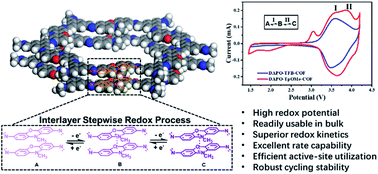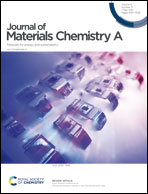Readily useable bulk phenoxazine-based covalent organic framework cathode materials with superior kinetics and high redox potentials†
Abstract
Redox-active covalent organic frameworks (COFs) with dense redox sites are promising electrical energy storage materials with robust architectures, high surface areas, insolubility in electrolytes, and open pores for electrolyte transportation. However, low redox potentials and poor electrical conductivity of pristine COFs often result in low accessibilities of redox-active sites and slow redox kinetics, greatly limiting their practical applications. Herein, we report the design and synthesis of two novel p-type phenoxazine-based COFs (DAPO-COFs) with high redox potentials (∼3.6 V vs. Li/Li+) and excellent electrical conductivities. Simply blended with conductive additives (CAs) and binders, pristine bulk DAPO-COFs without pre-composition with CAs or extra exfoliation are readily useable as cathode materials for lithium-ion batteries. Both as-synthesized DAPO-COF powders displayed superior active-site accessibility, ultrafast redox kinetics, and remarkable cycling stability. This work provides new perspectives on the development of readily useable COF-based cathode materials, and contributes to the advancement of eco-friendly and sustainable organic-based energy storage devices.



 Please wait while we load your content...
Please wait while we load your content...